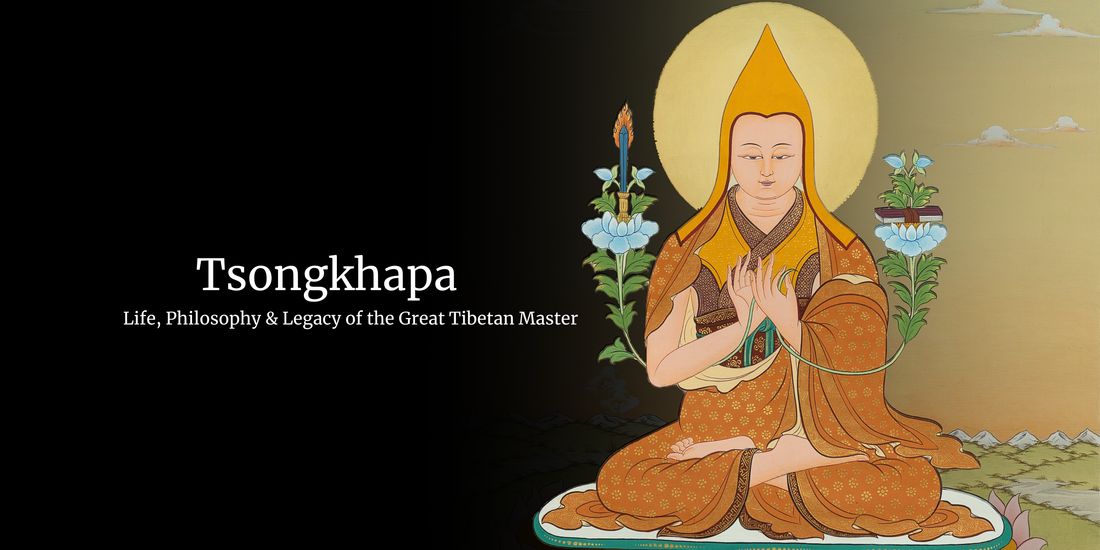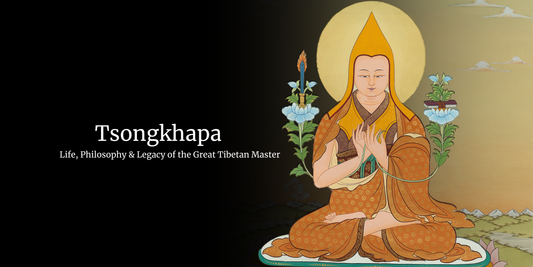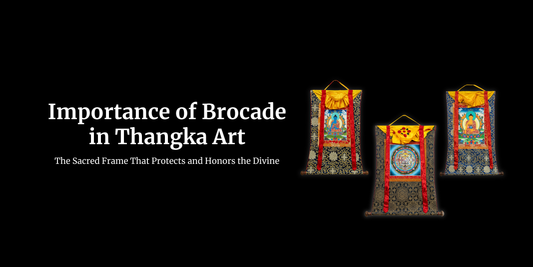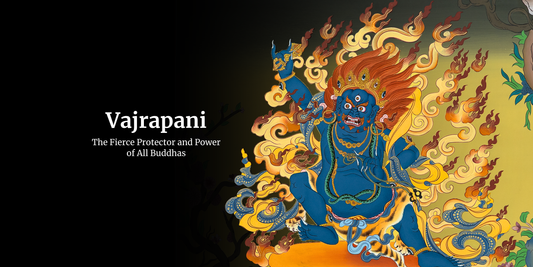- Buddhas Art of Healing
- Thangka Blog | Insights on Tibetan Thangka Art, Symbolism & Tradition
- Je Tsongkhapa: Life, Philosophy and Legacy of the Great Tibetan Master

Je Tsongkhapa: Life, Philosophy and Legacy of the Great Tibetan Master
The person who shaped an entire tradition of thought and practice: Je Tsongkhapa. He is the brilliant Tibetan master who redefined Buddhism.
The one who balanced the sharp logic, deep meditation, and unwavering ethics. Let’s dive into his fascinating life and teachings that guide monks, scholars, and spiritual seekers.
Who was Je Tsongkhapa?
Je Tsongkhapa (1357-1419) was one of Tibet’s most revered scholars, philosophers, and spiritual reformers. He is best known as the founder of the Gelug school of Tibetan Buddhism, often referred to as the “Yellow Hat” tradition, which gave rise to the lineage of the Dalai Lama.
Tsongkhapa's centrality lies in his unique ability to bridge profound intellectual scholarship with sincere, heartfelt spiritual practice.
He championed a path that integrated rigorous ethical discipline, systematic study of philosophy and logic, and dedicated tantric meditation.
His works, characterized by their unparalleled clarity and precision, continue to shape Tibetan Buddhist thought and practice to this day, making him a figure of immense importance both within religious circles and in modern academic study.
Early Life and Spiritual Training
Tsongkhapa was born in Amdo, Tibet. From an early age, he showed extraordinary intellectual and spiritual abilities; at the age of seven, he received novice monastic ordination.

Explore our Tsongkhapa thangka collection.
His endless thirst for knowledge led him on a journey across Tibet to study with the greatest master of his time.
-
Diverse influences: He studied under more than fifty teachers from all the major Tibetan Buddhist schools existing at the time: Sakya, Kagyu, and Nyingma. This ecumenical education gave him a vast and unparalleled understanding of the entire spectrum of Buddhist sutra and tantra.
-
Absorption of Lineages: Key among his teachers were Rendawa, a great Sakya scholar, and the Nyingma master Dolpopa Sherab Gyaltsen. He absorbed the Kadam tradition’s emphasis on lamrim (stages of the path) and bodhichitta, the Sakya teachings on logic and epistemology (pramana), and profound tantric initiations from various lineages.
- Integration: This period culminated in a deep, integrated realization where he saw no contradiction between the vast teachings of sutra and the profound methods of tantra, a synthesis that would become the hallmark of his own tradition.
Philosophical and Intellectual Contributions
Tsongkhapa’s intellectual legacy is remarkable, particularly in his reinterpretation of classical Madhyamaka thought.
1. Prasangika Madhyamaka: The Pinnacle of Views
Tsongkhapa provided a clear distinction between the prasangika and svatantrika approaches, advocating for a refined understanding of emptiness and avoiding philosophical extremes.
- Svatantrika Madhyamaka: Uses autonomous syllogisms to posit a position
- Prasangika Madhyamaka: Uses reductio ad absurdum (prasanga) arguments solely to dismantle an opponent’s position without asserting an independent thesis.
Tsongkhapa upheld Prasangika, as taught by Buddhapalita and Chandrakirti, as the highest and most accurate interpretation of emptiness. His unique contribution was his specific interpretation of what this means.
2. The View of Emptiness and the Two Truths
He emphasized the two truths: ultimate truth (emptiness) and conventional truth (phenomena’s apparent existence), balancing philosophical insight with practical ethics.
-
Emptiness as dependent arising: He famously stated, "One who sees the infallible cause and effect of all phenomena in samsara and nirvana is never captured by the extremes of existence or non-existence." For him, emptiness is dependent arising. Things are empty because they dependently originate.
-
Realism about conventional reality: This led to a robust realism about conventional phenomena. Because things are empty, they can function causally with precision. He rejected any view of emptiness that implied conventional reality was illusory or nonfunctional. Ethics, karma, and path structures remain entirely valid on the conventional level.
- Object of negation (dgag bya): A key to his system is correctly identifying the "object of negation," what is to be negated by the understanding of emptiness. It is not the conventional world itself but an innate misapprehension that phenomena possess inherent, independent existence (svabhava).
3. Epistemology and Logic
Tsongkhapa integrated the indian pramana (valid cognition) tradition of Djnaga and Dharmakirti into the core of the path.

Unlock this beautiful Tsongkhapa's thangka along his disciples with peaceful environment.
For him, rigorous logic and epistemology were not dry academic exercises but essential tools for cutting through misconceptions and arriving at a direct, non-conceptual understanding of reality.
Tsongkhapa’s Major Works and Texts
Tsongkhapa’s literary output was immense, but a few texts stand out as foundational pillars of the Gelug tradition.
|
Major Work |
Theme and Significance |
|
The Great Treatise on the Stages of the Path to Enlightenment (Lamrin Chenmo) |
His magnum opus. A comprehensive guide that synthesizes all sutra teachings into a single, graded path for practitioners of all levels, from initial reliance on a spiritual teacher to the direct realization of emptiness. |
|
The Great Exposition of Secret Mantra (Ngakrim Chenmo) |
A parallel work to the Lamrin Chenmo, providing a systematic detailed explanation of Vajrayana (tantric) theory and practice, emphasizing their integration with the sutra path. |
|
The Essence of Eloquence |
A profound and difficult text that clarifies the hermeneutics of interpreting the Buddha’s teachings, distinguishing definitive meaning (emptiness) from provisional meaning. |
|
In Praise of Dependent Arising |
A short, majestic hymn that encapsulates his core philosophical insight: the identity of emptiness and dependent origination |
|
Commentary on the “Madhuamakavatara” |
A detailed exposition on Chandrakirti’s “Entering the Middle Way,” which is the primary source of Tsongkhapa’s Prasangika Madhyamaka view. |
Establishment of the Gelug School
Tsongkhapa’s reforms culminated in the establishment of a new tradition, the Geluig, or “Virtuous Order.”
-
Founding of Monasteries: The institutional foundation was laid with the founding of Ganden Monastery in 1409, which became the seat of the Ganden Tripas, the spiritual heads of the Gelug school. This was soon followed by Drepung (1416) and Sera (1419) monasteries, which grew into among the largest monastic universities in the world.
-
Emphasis on Monastic Discipline: A cornerstone of his reform was a strict revival of Vinaya (monastic discipline). He insisted on celibacy, proper monastic robes, and ethical purity as the non-negotiable foundation for spiritual progress.
- Standardized Curriculum: The Gelug school developed a highly structured scholastic curriculum, grounded in Tsongkhapa's works, focusing on the "Five Great Treatises": Prajnaparamita (Perfection of Wisdom), Madhyamaka, Pramana, Abhidharma, and Vinaya.
Legacy and Influence: From Ganden Monastery to the Global Stage
Tsongkhapa’s legacy is not a relic of the past but a living force that continues to shape Tibetan Buddhism and beyond.
-
Architect of an Institution: His most immediate legacy was the Gelug school, which grew from the three great monasteries of Ganden, Drepung, and Sera to become Tibet's dominant spiritual and political force.
-
A Lineage of Leadership: This institutional foundation paved the way for the Dalai Lama lineage. From the Great 5th Dalai Lama to the present 14th, each has been trained within the intellectual and spiritual framework Tsongkhapa established, making his philosophy the bedrock of Tibet's most visible leadership.
-
A System That Travels: The rigor and clarity of his "Stages of the Path" (Lamrim) system have made it uniquely portable. Today, it is taught in global Dharma centers from the West to the Himalayas, ensuring his teachings resonate far beyond their Tibetan origins.
- Academic Acclaim: Beyond the monastery, scholars worldwide recognize his work. Resources like the Stanford Encyclopedia of Philosophy treat his interpretations of Madhyamaka as a major contribution to global philosophical thought, analyzing his arguments alongside those of Kant and Hume.
 Clich here to view this beautiful Tsongkhapa's thangka depicted in a very peaceful environment with hills, trees, rivers, a beautiful landscape
Clich here to view this beautiful Tsongkhapa's thangka depicted in a very peaceful environment with hills, trees, rivers, a beautiful landscape
Critiques and Debates: The Clash of Philosophical Titans
Tsongkhapa’s bold and specific interpretations didn’t just inspire followers; they sparked intellectual fires that burned for centuries, engaging the finest minds from rival traditions.
-
The Heart of the Controversy: The central debate swirled around his unique interpretation of Prāsaṅgika Madhyamaka. Critics argued that his razor-sharp distinction between what is "truly established" versus "conventionally real" was itself a subtle reification.
-
The Sakya Counter-Argument: Prominent Sakya philosophers like Gorampa Sonam Senge contended that Tsongkhapa's view of emptiness was too "coarse" and intellectual. They famously accused him of promoting a "blanket of negation" that wasn't thorough enough, leaving a residue of conceptual attachment to conventional reality.
-
The Kagyu Perspective: The Eighth Karmapa, Mikyö Dorje, a key Kagyu critic, authored extensive refutations. He argued that Tsongkhapa's system was overly complex and rational, potentially obscuring the direct, non-conceptual realization of emptiness favored in Kagyu meditation traditions.
- An Enduring Dialogue: Far from being a weakness, these intense debates highlight the vitality of Tibetan Buddhist philosophy. They forced each school to refine its positions, and the discourse over Tsongkhapa's ideas remains a vibrant and essential area of scholarly study to this day.
Timeline of Tsongkhapa’s Important Life Events
- 1357: Born in Amdo, Tibet
- 1363: Receives Novice ordination at the age of seven
- 1373-1385: Travels to Central Tibet, studies with masters from all traditions.
- 1409: Establishes Ganden Monastery, founding the Gelug school. Institutes the Great Prayer Festival (Monlam) in Lhasa
- 1416: Drepung Monastery founded by his disciple.
- 1419: Sera Monastery founded by his disciple. Tsongkhapa passes away at Ganden
Today, Tsongkhapa’s teachings are widely studied for their clarity, ethical emphasis, and integration of theory and practice. Translation projects, academic research, and modern meditation centers continue to make his works accessible worldwide, ensuring his legacy informs both scholarship and spiritual practice.
His legacy is not just a school of Buddhism but a timeless invitation to pursue a path of wisdom, compassion, and unshakable inner peace through a balanced integration of study, reflection, and meditation.

1. Why is the Gelug School called the “Yellow Hat” School?
The term “Yellow Hat” is a historical moniker. Tsongkhapa and his followers revived the practice of wearing the yellow ceremonial hats of the ancient Indian Buddhist monastic code as part of their Vinaya reform to distinguish themselves from other schools whose practices had become more relaxed. It symbolizes their emphasis on strict monastic discipline.
2. Was Je Tsongkhapa only a philosopher, or also a meditator?
He was both, in the highest degree. History describes him as a dedicated meditator who spent years in retreat. His philosophical works are not mere intellectual constructs but are designed as manuals to be used in analytical meditation to generate direct experience.
3. What is the significance of the Lamrin Chenmo?
The Lamrin Chenmo is a comprehensive roadmap that organizes all the teachings of the Buddha into a single path that progressively leads a practitioner from a beginner’s state to full enlightenment. It is valued for its practicality, clarity, and its integration of the entire scope of sutra teachings.
If you were oulled by Je Tsongkhapa's story and his contributions, then you can explore his thangka from Buddha's Art of Healing.



